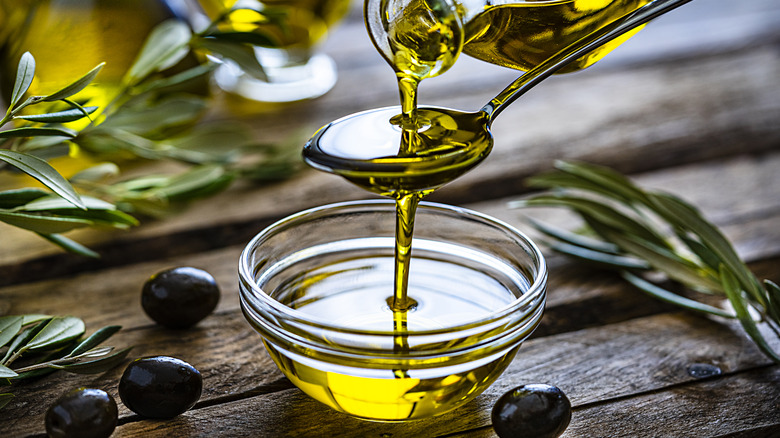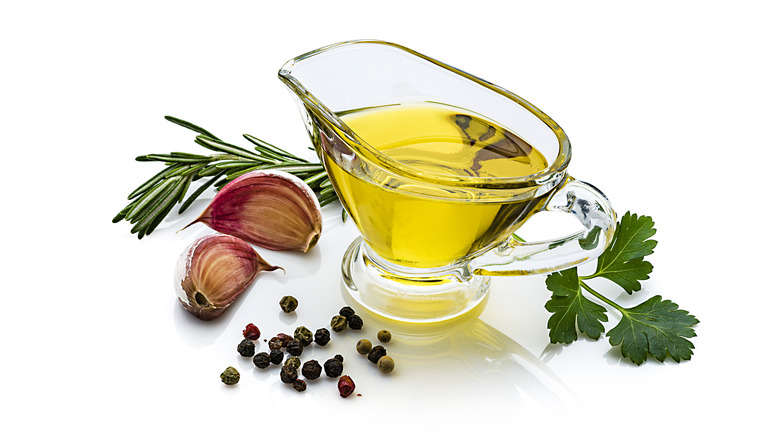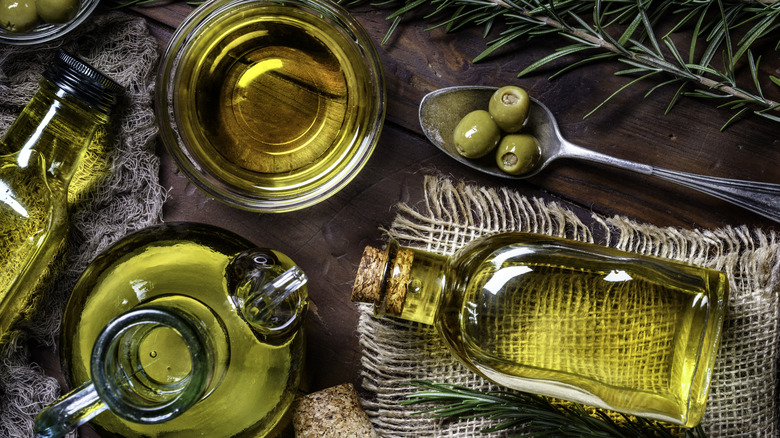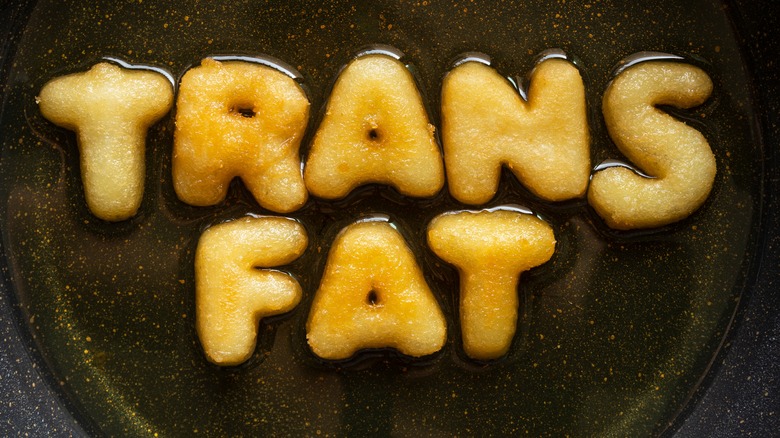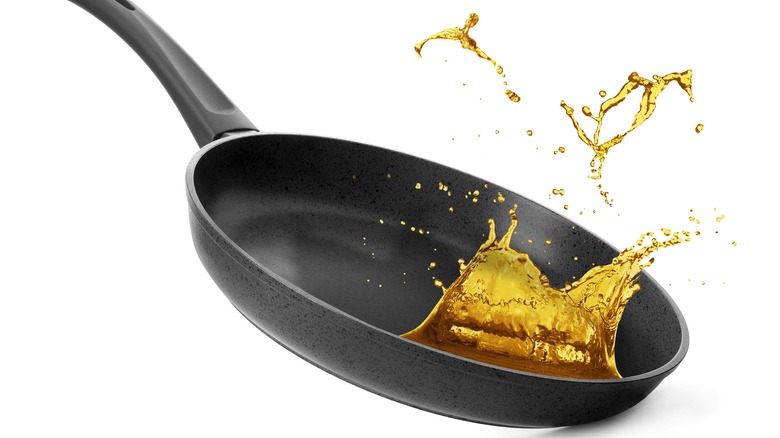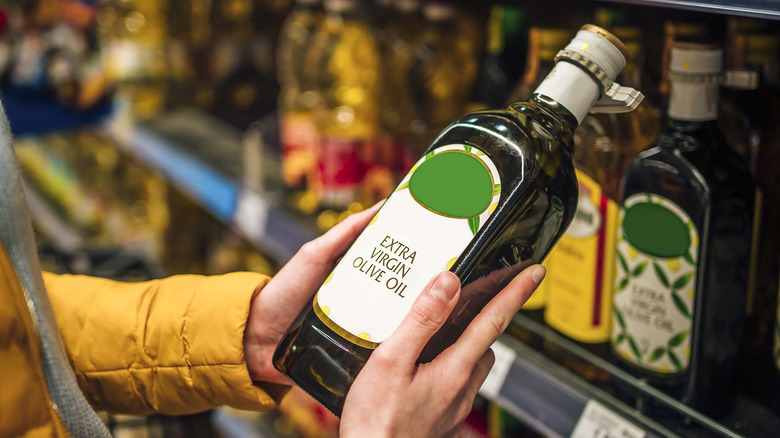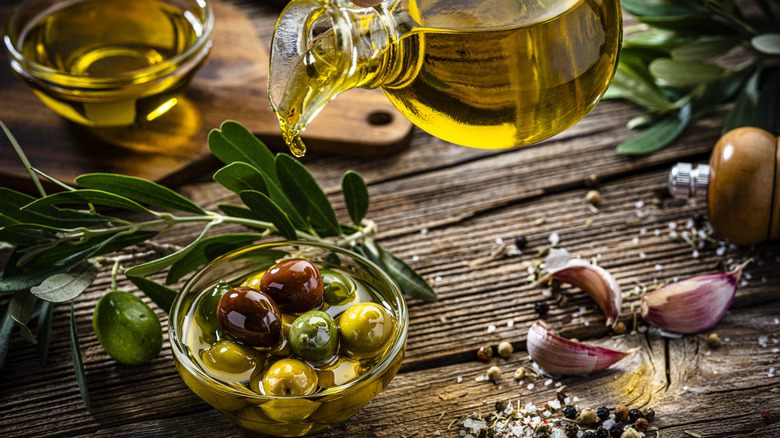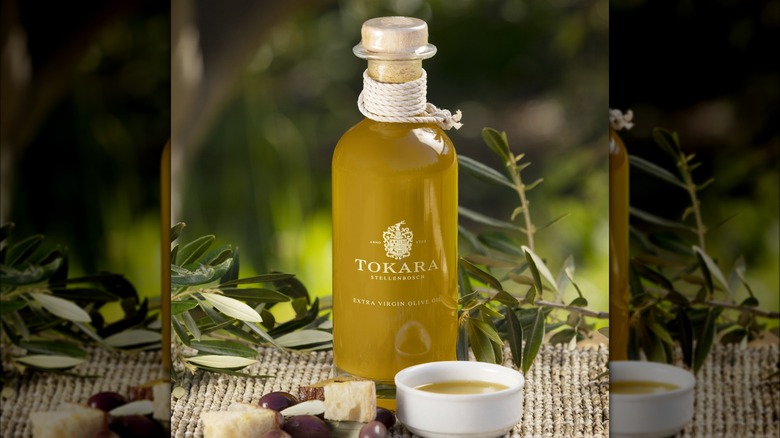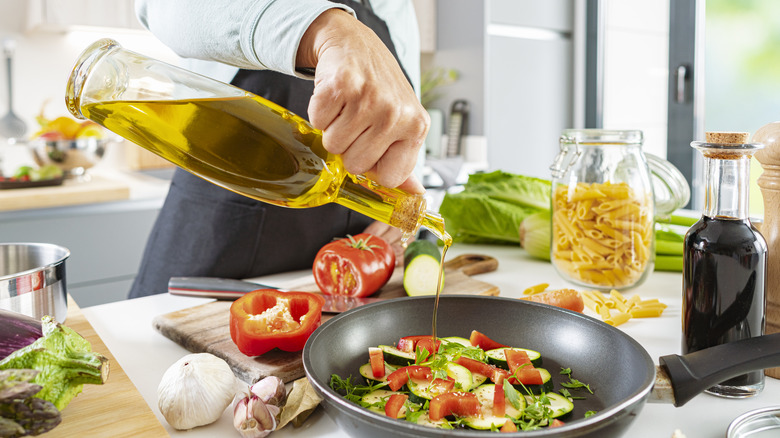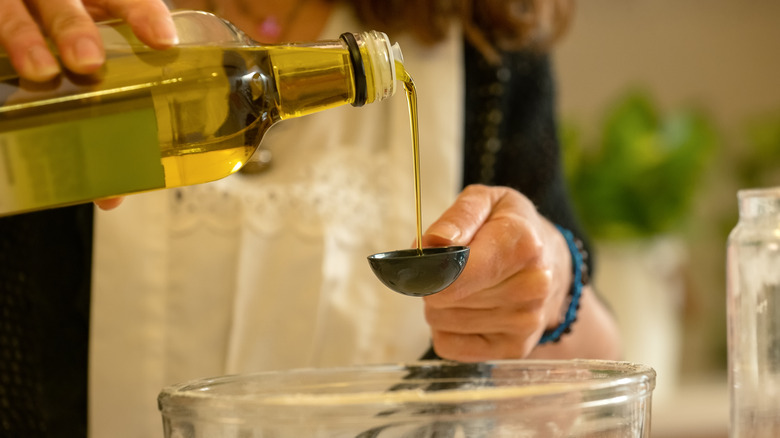False Facts About Olive Oil You Thought Were True
Integral to Mediterranean cuisine, olive oil is obtained by crushing or pressing the fruit of the olive tree. There are several grades of olive oil, each with its own unique nutritional profile and flavor characteristics. Among these, extra virgin olive oil is the highest quality, produced by pressing olives without the use of chemicals or heat. Just like extra virgin olive oil, virgin olive oil is produced by cold-pressing olives, with the only difference being that it has slightly higher acidity than its superior counterpart. Other popular types of olive oil include refined, pure, and light varieties.
Although extra virgin olive oil is considered to be the most beneficial when it comes to health, all grades of olive oil offer some potential health benefits. Regardless of type, olive oil contains high levels of monounsaturated fatty acids, which may help to reduce LDL (or "bad") cholesterol. Olive oil is also laden with antioxidants that may help fight inflammation.
Americans have been producing olive oil for well over a century and consume around 90 million gallons each year, a demand that's second only to Europe. Despite its widespread appeal and long history, many misconceptions about olive oil persist. Eager to uncover the truth about olive oil? Keep reading!
False: Light olive oil is low in calories and fat
In the world of food labeling, the word "light" usually doesn't refer to taste. Instead, it more typically points to a product's lower fat content. This promotional strategy aims to attract health-conscious consumers looking for less fatty eating alternatives. When it comes to the labeling of olive oil, however, light doesn't denote the product's fat content, but rather its flavor and color.
Light olive oil has been refined to remove much of its original flavor and color, resulting in a product with a lighter taste and more neutral hue than other types of olive oil. Many chefs and home cooks prefer light olive oil because its mild flavor pairs well with culinary creations such as salad dressings and sauces. Moreover, the term "light" is only used for marketing purposes, as the USDA officially recognizes this category of the product as "U.S. refined olive oil."
In reality, most grades of olive oil — including light olive oil — have approximately the same fat content, with each tablespoon containing about 14 grams of fat. It's not all bad news, however, because 73% of the fat in olive oil comes from monounsaturated fats, which are widely recognized as a healthier fat option.
False: The color of olive oil is indicative of its quality
Olive oil comes in many different hues, from golden yellow to deep green and even purple tones. The color of this pantry staple depends on several factors, including the type of fruit used to produce the oil, the time that the fruit was harvested, and how the oil was made. For instance, olive oils with a dark green hue are usually derived from fruit picked early in the harvest season. Meanwhile, olive oils with a golden yellow color are often made from ripe olives that have been picked later in the season. Once pressed, the pigment in the olive's flesh and skin also influences the color of the final product.
Instead of color, the best indicators of olive oil's quality and freshness are its smell and taste. Indeed, professional olive oil tasters sample olive oil out of blue glasses so as not to be influenced by its color. High-quality olive oil is characterized by fresh, fruity flavors, which can include bitter and peppery notes depending on the variety. As a rule of thumb, greener olive oils tend to be fruitier and grassier in flavor, while golden olive oils usually exhibit a richer and spicier taste.
False: Olive oil must be stored in the refrigerator
While refrigerating certain products can prevent them from going rancid or will work to prolong their shelf life, olive oil isn't one of them. Generally speaking, olive oil doesn't require refrigeration — in fact, putting your olive oil in the fridge may not be the best idea. For one, the product starts to thicken at approximately 54 degrees Fahrenheit. Refrigeration can also cause olive oil to crystallize or give it an unsightly cloudy appearance. Once the temperature of olive oil drops to around 43 degrees Fahrenheit, the product will turn semi-solid.
Instead of refrigeration, it's best to store olive oil in a cool and dark place, away from heat sources like stoves and direct sunlight. To maintain the quality and freshness of olive oil, keep the storage area between 57 and 70 degrees Fahrenheit. Additionally, storing olive oil in a dark-colored bottle or container is a great way to protect it from sunlight. It's also important to ensure that the container is well-sealed to keep air from oxidizing the oil and thus diminishing its overall quality.
False: Heating olive oil creates trans fats
Trans fats, or trans-fatty acids, are a type of unsaturated fat that can lead to health issues such as heart disease when consumed in large quantities and over long periods. Most trans fats are created through a process that involves adding hydrogen to vegetable oil to make it more solid. This method is often used to increase the shelf life of products such as shortening, margarine, microwave popcorn, and some fried foods.
The belief that heating olive oil creates trans fats likely stems from this, as well as confusion about what happens when you heat cooking oils. Essentially, heating olive oil doesn't involve hydrogenation and so can't produce trans fats. For example, a study published in Grasas y Aceites found that olive oil used to fry potatoes at 356 degrees Fahrenheit for 15 minutes on eight separate occasions produced minimal trans fats of 0.002%.
False: Olive oil can't be used for cooking on high heat
The myth that olive oil can't be used for high heat cooking methods is rooted in the belief that it has a relatively low smoke point compared to other oils. When an oil reaches its smoke point, it undergoes changes that can negatively affect its flavor and nutritional value.
In reality, the smoke point of olive oil isn't all that low, making it suitable for frying. How does it compare with other oils? The smoke point of olive oil stands at between 374 and 405 degrees Fahrenheit, very similar to canola oil, which has a smoke point of 400 degrees Fahrenheit.
An oil's oxidative stability may be more important than its smoke point. Virgin and extra virgin olive oil tend to be very stable and resistant to oxidation, which can happen when oil is exposed to light, heat, or oxygen. Oxidation can produce harmful compounds and off-flavors. This stability can be attributed to the high levels of monounsaturated fats and antioxidants in virgin and extra virgin olive oil, as well as the fact that they are unrefined.
False: Extra virgin olive oil is the healthiest variety
Extra virgin olive oil is widely considered to be one of the healthiest oils due to its high levels of monounsaturated fats and antioxidants. This kitchen essential has been credited with lowering LDL cholesterol levels, reducing blood pressure, and boosting blood vessel function. Olive oil also has anti-inflammatory properties that can alleviate symptoms of chronic conditions such as arthritis. Moreover, extra virgin olive oil supports brain function and cognitive health, potentially reducing the risk of Alzheimer's disease, though studies into this effect are ongoing.
While extra virgin olive oil is renowned for its health benefits, other oils are equally as impressive. For instance, avocado oil is gaining popularity for its high levels of monounsaturated fats and vitamin E. Additionally, avocado oil is relatively flavorless, making it a great addition to dishes with delicate flavors. Another notable option is sunflower oil, known for its high vitamin E content and (perhaps not so healthy) omega-6 fatty acids. Many also favor canola oil for its low aturated fat and high levels of monounsaturated fats.
False: Olive oil improves with age
Unlike fine wines and cheese, which can improve in flavor, complexity, and value over time, olive oil doesn't benefit from aging. In reality, the quality of olive oil deteriorates the longer it sits in your pantry because it contains fats that are prone to oxidation, a factor that increases acidity and negatively affects flavor.
Olive oil bottles generally come with a best-by date that indicates how long the product will retain its optimal flavor and quality. This time frame is based on several factors such as olive variety and when it was harvested, as well as how it was processed. Environmental conditions like packaging and storage conditions can also affect the shelf life of olive oil.
Extra virgin olive oil usually maintains its quality longer than other olive oils, thanks to its lower acidity. If appropriately stored, extra virgin olive oil will retain its quality for between 18 and 24 months from its harvest date, which usually appears on the bottle. However, once opened, it's best to use any type of olive oil within a few months.
False: Cloudy olive oil means that it's gone bad
People tend to think that cloudy olive oil means it's gone off because they associate clear oil with purity and quality. In reality, oil can become cloudy for several reasons, none of which have anything to do with its quality.
One of these is exposure to cold temperatures in the refrigerator or even pantry. When oil falls below a certain temperature, it will start to solidify, leading to a cloudy appearance. Leaving the olive oil at room temperature or gently warming it up will return it to its clear state. Cloudiness in olive oil can also indicate the presence of particles from the olives themselves, particularly if the product is unfiltered. If olive oil is left undisturbed, this sediment should accumulate at the bottom of the container.
While cloudiness doesn't usually mean that it's gone off, there are certain instances where changes in olive oil's appearance can indicate spoilagem as exposure to light and air can affect the appearance of olive oil and degrade its quality over time. If the olive oil smells or tastes off, it's probably best to throw it away.
False: Olive oil shouldn't be used on nonstick pans
Usually made from stainless steel, nonstick pans are commonly coated with PTFE or Teflon, which gives them their non-stick properties. Recently, some cookware companies have warned shoppers that using olive oil on their products could damage them.
The idea that using olive oil can damage nonstick pans is based on the oil's purportedly low smoke point. It's commonly thought that when olive oil is heated past its smoke point, the product is likely to leave an unpleasant residue that can degrade the nonstick coating on pans. However, this concern is largely unfounded.
The smoke point of olive oil peaks at 470 degrees Fahrenheit. Meanwhile, the smoke point of extra virgin olive oil ranges between 350 and 410 degrees Fahrenheit, depending on its level of fatty acids. Considering that the normal range of cooking temperatures on a stovetop hovers around 350 degrees Fahrenheit, the possibility of olive oil damaging nonstick pans by surpassing its smoke point is minimal, at least during everyday cooking.
False: Olive oil shouldn't be used in baking
Butter is a staple ingredient in many baking recipes due to its ability to add richness, flavor, and moisture to baked goods. However, butter is high in saturated fats and calories. Luckily, when it comes to baking, there's an alternative: olive oil.
Not only is olive oil healthier than butter, but it can imbue baked goods with a moist texture and leave them light and spongy. It can also add a lovely, subtle flavor to some recipes. The key to replacing butter with olive oil is to substitute each tablespoon of butter with three-quarters of a tablespoon of olive oil. Additionally, if the recipe requires canola or vegetable oil, you can substitute it with a one-to-one ratio of olive oil.
Not all baked goods lend themselves to olive oil, however. Recipes that require melted butter are perfect candidates for subbing in olive oil. However, this flexibility doesn't extend to recipes that require the use of butter in its solid form, such as biscuits that involve folding cold butter into batter. Adding liquid olive oil can adversely affect the texture of these baked goods.
False: Most olive oil is produced in Italy
The perception that most olive oil comes from Italy is rooted in the fact that a lot of the olive oil on supermarket shelves in the U.S. carries Italian labels. However, appearances can be deceiving. Although Italy ranks as the second-largest producer of olive oil in the world, it produces significantly less of the product than Spain. In the 2023-2024 season, Spain produced an estimated 766,000 tons of olive oil, whereas Italy produced about 288,000 tons in the same period.
Why isn't Spanish olive oil as visible on North American supermarket shelves as Italian olive oil? The reason is quite simple. Italy imports significant quantities of olive oil from Spain to meet its export demands. Italian manufacturers then bottle that oil, which is then frequently sold with Italian branding. The product may even be rather deceptively labeled as "Made in Italy" or a "Product of Italy." Currently, however, this practice is perfectly legal.
False: Most extra virgin olive oil in the supermarkets is fake
The belief that most extra virgin olive oil sold in U.S. supermarkets is fake stems from several studies that have been published over the years. For instance, studies published by UC Davis in 2011 indicated that over two-thirds of extra virgin olive oil available in California doesn't adhere to the required quality standards.
However, while many of the tested products failed to meet the set standards for taste or quality, the study didn't find that the products had been adulterated with substandard oils. "[The results] partly got misinterpreted because it's easier in the media to report that something's fake," explained Dan Flynn, the executive director of the UC Davis Olive Center in 2016 (via The Seattle Times).
Moreover, the North American Olive Oil Association, which has carried out random testing of olive oil over the past two decades, has found that only around 2% of the olive oil sold in the U.S. is adulterated. The organization plans to expand its testing program in 2024 to guard against counterfeit olive oil products.
